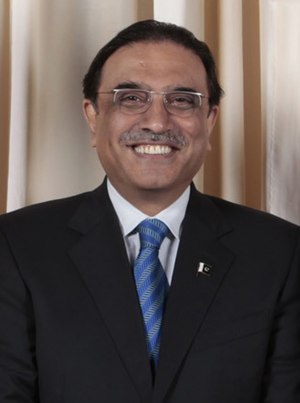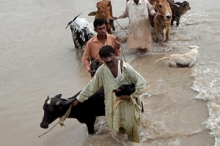"It's about Pakistan's ability to move forward and survive this difficult situation," he said.
The US and the Western world's most crucial ally in the fight against terrorism is on its knees and it has never been a more dangerous time for the already unstable democratic nation.
Pakistan, already overwhelmed by a serious economic downturn and spiralling Taliban insurgency, is facing the worst natural disaster in more than a century.
The government's stocks are so low as to be almost subterranean, such is the anger among the populace over its perceived failure to prepare for, then respond adequately to, the crisis.
Pakistan watchers have nervously noted the glorification of the military's rescue efforts in the past two weeks and the relentless attacks on the country's democratically elected President, Asif Ali Zardari.
No one has failed to notice the widespread presence of militant charities, among the first to mobilise aid across the worst hit and most remote areas of the unstable northwest. Or that three weeks into this crisis the increasingly desperate pleas for aid -- from the government, the UN, the US and from international aid organisations of all stripes -- are only now being heard.
The world has been slow to recognise the extent of the disaster and even slower to open its pockets, a combined result perhaps of a relatively low death rate compared with other disasters and an inherent distrust of a country racked by systemic corruption.
So far, donor nations -- led by the US -- have pledged nearly $US200 million ($213m).
The World Bank yesterday offered a $US900m loan to the debt-laden nation, already $US11 billion in hock to the International Monetary Fund.
One-quarter of the country is inundated. Billions of dollars of infrastructure, agriculture and homes have been washed away and will need to be rebuilt, at a cost the Pakistan government estimates at about $US15bn.
Twenty million people have been affected by the floods, two million are homeless and six million are reliant on government and aid groups for food and water.
UN Office for the Co-ordination of Humanitarian Affairs spokesman Maurizio Giuliano tells The Australian that relief agencies so far have managed to bring clean water to just one million of the six million people in need. "We're just not able to get enough funding," he says. "If you only have 30 per cent of the funds you need then how can we buy food and tents?"
While the Pakistan government refuses to acknowledge cholera outbreaks, aid workers say the potentially fatal water-borne disease is evident right across flood-hit areas and the country is facing a second wave of mass deaths. "The people that have been affected are so many that if you don't act fast enough we could very soon see many more people dying because of lack of clean water, medicines and lack of food," Giuliano says.
Right now the country cannot cope with a health crisis. Hospitals across flood-ravaged areas have been damaged and medical staff are under serious strain. In Pakistan's Himalayan region of Gilgit-Baltistan last week, doctors at the only local hospital were working by candlelight. In one case, a new mother's episiotomy wound was stitched by the weak light of a doctor's mobile phone.
"In the antenatal and post-partum . . . flies circle beds covered by soiled and wrinkled sheets," visiting doctor and postdoctoral fellow Emma Varley reports, adding that "without water or power the beds hadn't been changed in over a week".
"The pressures placed on this hospital by the needs of an estimated 1.5 million residents are profound."
On Monday, angry flood survivors in the President's home province of Sindh took to the streets in protest, demanding more relief. Many more such demonstrations will surely follow.
Food prices have already doubled in markets across the country and are tipped to rise further. Analysts estimate 30 per cent to 40 per cent of the country's agricultural production has been wiped out.
It does not take a particularly astute observer to understand the ground is ripe for serious political upheaval.
In Pakistan's short 63-year history there has only been one response to crises: a military coup. Analysts are now fiercely divided over the likelihood of such a scenario. Veteran Pakistan commentator and former military colonel Talat Masood says it is unlikely given the present circumstances.
"As if we didn't have enough trouble already. That would be a disaster for Pakistan," he tells The Australian, adding: "There's nobody thinking of challenging the government because of the floods.
"Obviously the government in the beginning was slow to respond but the magnitude of the devastation was such that even the best of governments would have had difficulty meeting the need."
Masood says the floods present an opportunity to rebuild Pakistan in a safer, more equitable way and concedes new leadership could well emerge out of the crisis to challenge Pakistan's moribund political landscape.
"The question is how to transform a great tragedy into a great opportunity," he says.
"This is an opportunity to build new infrastructure that's more solid, build houses that are much safer, bridges that are stronger and an economy based on indigenous production. People have gone through something they will never forget and only those governments who can deliver will last."
Former North-West Frontier Province secretary-general and analyst Rustam Shah Mohmand says a military coup can never be ruled out in a nation that has surrendered to army rule for almost half its history.
"The military is already in the driver's seat so why should they take over now and accept all the blame for the problems to come," Mohmand says.
But he adds: "In the past the military [has] brushed aside those calculations and taken over and ruled the country for a major part of its existence, so you can't completely rule it out."
A recent survey of 2000 Pakistani adults by the Pew Research Centre's Global Attitudes Project found just 20 per cent of respondents approved of Zardari while 61 per cent viewed Pakistan army chief Ashfaq Parvez Kayani favourably.
Pakistan commentator and editor of influential cyber-magazine Pak Tea House Raza Rumi also warns of systemic collapse if the needs of millions of poor -- and now destitute -- Pakistanis are not met soon.
"The people in southern Punjab and Khyber Pakhtunkhwa [two areas known for militancy] are extremely angry and frustrated at the inability of the state to act in a timely and purposeful manner, he writes in a PTH blog.
"Jamast-ud-Dawa [the charity arm of banned militant group Lashkar-e-Toiba] is already at the forefront of relief efforts in the Punjab, while several offshoots of the militants' alliances in the northwest are capitalising on the extraordinary situation that we face today. It is not beyond the realm of possibility that these two parts of Pakistan, already poor, marginalised and victims of state neglect, would see a major swing towards Islamism."
The floods have caught Pakistan badly off-guard. A year of rolling military operations against Taliban and other extremists in the northwest and tribal border areas had finally started to weaken the insurgency.
The military successes in previous Taliban strongholds, and evidence the security establishment for once was unified in its efforts to rout the extremists, had won it increasingly popular support. But a Marshall plan for the conflict-affected areas had not yet been properly devised or implemented and the floods have turned the clock backwards.
And the hardship has really only just begun. Murtaza Haider, a professor in supply chain management and logistics at Toronto's Ryerson University, says the price of basic staples has already risen 100 per cent to 200 per cent in the past few weeks as food stocks run dangerously low.
About 7.3 million hectares of productive crop land has been wiped out and, thanks to the country's limited food storage capacity, it faces the prospect of having to import basic foodstuffs for at least the next year.
"We are going to see a situation where not just the low income but also mid and high-level income households will have a very tough time paying for the food they consume," Haider tells The Australian.
Even before the floods, the World Food Program assessed 50 per cent of Pakistan's 170 million people as being "food insecure". But the convergence of floods, the inflationary effect of the Islamic month of Ramadan and the wheat crisis -- which has caused prices to rise 90 per cent since June -- could "render a much larger proportion of the Pakistanis unable to secure basic food items at affordable prices".
"Pakistan has suddenly become even more food insecure while being armed with nuclear weapons," he says. Haider estimates it will be two years before the mainstream agricultural production cycle is back on track, "so people around the world are going to have to be very generous to Pakistan".
"The problem is those who were involved in agriculture have been uprooted and it will take some time to resettle them. Then you need time to get seed supplies, farm equipment.
"You look at the tsunami and the Haiti earthquake, the sheer human toll of those events was obvious so quickly, but in Pakistan its the other way around. You could not have saved the people who died in the tsunami but here at least we have a chance."









